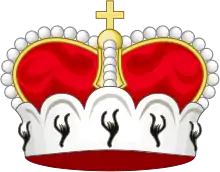Peerage of England
The Peerage of England comprises all peerages created in the Kingdom of England before the Act of Union in 1707. In that year, the Peerages of England and Scotland were replaced by one Peerage of Great Britain.
 |
| Part of a series on |
| Peerage |
|---|
| House of Lords |
|
English Peeresses obtained their first seats in the House of Lords under the Peerage Act 1963 from which date until the passage of the House of Lords Act 1999 all Peers of England could sit in the House of Lords.
The ranks of the English peerage are, in descending order, Duke, Marquess, Earl, Viscount, and Baron. While most newer English peerages descend only in the male line, many of the older ones (particularly older baronies) can descend through females. Such peerages follow the old English inheritance law of moieties so all daughters (or granddaughters through the same root) stand as co-heirs, so some such titles are in such a state of abeyance between these.
Baronets, while holders of hereditary titles, as such are not peers and not entitled to stand for internal delegation, that is election, in the House of Lords. Knights, Dames and holders of other non-hereditary orders, decorations and medals are also not peers.
In the following table, each peer is listed only by his or her highest English title (with the exception of the Duke of Norfolk/Earl of Arundel) showing higher or equal titles in the other peerages. Those peers who are known by a higher title in one of the other peerages are listed in italics.
Dukes in the Peerage of England
| Title | Creation | Other Dukedom or higher titles |
|---|---|---|
| The Duke of Cornwall | 1337 | Usually Prince of Wales as the heir to the British throne; Duke of Rothesay in the Peerage of Scotland. |
| The Duke of Norfolk | 1483[1] | |
| The Duke of Somerset | 1547 | |
| The Duke of Richmond | 1675 | Duke of Gordon in the Peerage of the United Kingdom; Duke of Lennox in the Peerage of Scotland. |
| The Duke of Grafton | 1675 | |
| The Duke of Beaufort | 1682 | |
| The Duke of St Albans | 1684 | |
| The Duke of Bedford | 1694 | |
| The Duke of Devonshire | 1694 | |
| The Duke of Marlborough | 1702 | |
| The Duke of Rutland | 1703 | |
Marquesses in the Peerage of England
| Title | Creation | Other Marquisette or higher titles |
|---|---|---|
| The Marquess of Winchester | 1551[2] | |
Earls in the Peerage of England
Viscounts in the Peerage of England
- Subsidiary title.
| Title | Creation | Other Viscountcy or higher titles |
|---|---|---|
| The Viscount Hereford | 1550[6] | |
| The Viscount Townshend | 1682 | Marquess Townshend in the Peerage of Great Britain. |
| The Viscount Weymouth | 1682 | Marquess of Bath in the Peerage of Great Britain. |
Barons and Baronesses in the Peerage of England
- Subsidiary title.
See also
- British Honours System
- British nobility
- Forms of address in the United Kingdom
- Gentry
- History of the Peerage
- Landed gentry
- Baronetages of England, Nova Scotia, Great Britain, and the United Kingdom
- Peerage, an exposition of great detail
- Peerage of Ireland
- Peerage of Scotland
- Welsh peers and baronets
References
- Premier Duke of England
- Premier Marquess of England
- G.E. Cokayne; with Vicary Gibbs, H.A. Doubleday, Geoffrey H. White, Duncan Warrand and Lord Howard de Walden, editors, The Complete Peerage of England, Scotland, Ireland, Great Britain and the United Kingdom, Extant, Extinct or Dormant, new ed., 13 volumes in 14 (1910–1959; reprinted in six volumes, Gloucester, U.K.: Alan Sutton Publishing, 2000), volume I, page 233.
- Premier Earl of England
- Debretts Peerage
- Premier Viscount of England
- Premier Baron of England
